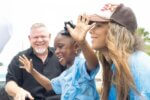Heart disease, cancer, diabetes, and AIDS are major killers in the U.S. and, as a result, tend to receive widespread attention and research dollars. But 7,000 other rare diseases get far less attention, even though they collectively strike millions of Americans.
Many patients with such conditions suffer alone, discovering that it is often difficult to get information about their disorders and that limited resources are available to help them.
That’s why the National Organization of Rare Disorders (NORD) is observing Rare Disease Day on Leap Day to raise awareness of such conditions and their impact on patients’ lives. This year’s theme, “Patient Voice,” centers on the crucial role that patients must play in advocating for their care to improve their lives and those of loved ones and caregivers.
The organization was founded in 1983 by Abby Myers, a Connecticut mother, who was frustrated by the lack of research, information, and support for her children who had Tourette’s syndrome.
Today, families can look to this organization for background on more than 1,300 of these rare conditions.
The National Institutes of Health, which recognizes Rare Disease Day, defines rare disorders as those that affect fewer than 200,000 Americans. But, if you want to find out information about something specific that has impacted you or your family, patient information can be hard to come by.
Mary Dunkle, an educator at NORD, said although some of these diseases are incredibly rare, altogether they affect about 30 million Americans. One condition, ATF type 1 autoimmune polyglandular disease, affects only about 200 people countrywide.
“There are lots of organizations that support patients, but some of them are what we call “kitchen table groups,” Dunkle explained. “These groups have funded grants and set up websites. Much of the research done on rare diseases is funded by grants, patients and families, and small organizations.”
Myers, NORD’s founder, served as president for 25 years. When patient advocates became active they managed to get legislation passed—the Orphan Drug Act—which gets funding from companies to develop research for rare diseases.
The organization’s motto: “Alone we are rare; together we are strong.”
Dunkle said that sense of community has helped to raise awareness and get health policy in place to benefit sufferers. One family struggling for support with a rare disease may find a dearth of information unless other patients and their families have done some groundwork ahead of time, she noted.
Today, NORD is an advocate for people with rare diseases. Its members are involved in education for patients, physician awareness, and education for medical students. The patient services component of NORD helps people find specialists, or ways to pay for expensive treatments or medications that they might not be able to afford.
NORD also operates research programs to help study diseases that few people have. NORD is also affiliated with 230 separate patient organizations. The group’s main headquarters is in Danbury, Connecticut, with other offices in Washington, D.C., and Quincy, Massachusetts.
While there are plenty of diseases listed as rare that many of us have heard of – like measles and mumps, which strike few U.S. children, thanks to vaccines – there are plenty of others that are much less well known. Among them:
Tinnitus. Also known as “ringing in the ears,” tinnitus is still a puzzle to many doctors. Those with the condition have the perception or sensation of sound, even though there is no identifiable source. The noise may be hissing, chirping, crickets, whooshing or roaring sounds. Subjective tinnitus is a purely electrochemical phenomenon that no one else can hear, but objective tinnitus, which is even rarer, happens when sound comes from somewhere in the body. These cases might be prompted by disorders in the blood vessels and muscles, or neurological issues.
Alopecia areata. This condition causes the loss of hair, sometimes in small patches and other times in bigger areas. This disease is another mystery because it could be an autoimmune disorder, but there is no predictable course of the disease. Some people lose a lot of hair, some lose a little; it can grow back and then fall out again.
Kawasaki Disease. This rare disorder is a multisystem inflammatory disease of the blood vessels. Symptoms include high fever, reddish skin, rash, and swelling of the lymph nodes. It is the primary cause of acquired heart disease in children in the United States, usually under five years of age. But there are only 3,000 cases each year so it may not be the first your child’s pediatrician considers.
Addison’s Disease. People with this condition have vague symptoms that develop over time, often leading to inaccurate diagnoses. Symptoms can be hyperpigmentation, fatigue, low blood pressure, and dehydration, but the end result — acute adrenal failure — is quite serious.
Hairy tongue disease. Although this is not a life-threatening disease (nor is it infectious), there is so little available information about it that NORD is the best resource for finding out what it really is.
NTM. Short for nontuberculous mycobacteria, NTM are naturally-occurring bacteria found in water and soil that can contaminate shower heads in homes and cause lung infections. Most people do not become ill but for some susceptible individuals, it causes a slowly progressive and destructive disease.
SSCD. Superior semicircular canal dehiscence (SSCD) is a curious condition caused by tiny holes in the bones encasing the inner ear. This causes sufferers to hear sounds most of us never imagined — including the beating of their hearts, the digestion of food in their stomachs, and even the movement of their eyes.
VACTERL syndrome. This rare defect can cause a child’s esophagus to become unattached from his or her trachea, or serious issues in the development of a person’s stomach, heart, and lungs.
EOE. Short for eosinophilic esophagitis, this mysterious condition makes it hard to swallow. For reasons doctors don’t entirely understand, cases of EOE are rising in the U.S.
- For more information about these conditions and the full list of rare diseases—all 7,000 of them—visit the NORD Website or the NIH online resource list.
- To learn more about Rare Disease Day, visit the event’s Website.
For the original article, visit newsmaxhealth.com.







Leave a Comment
You must be logged in to post a comment.